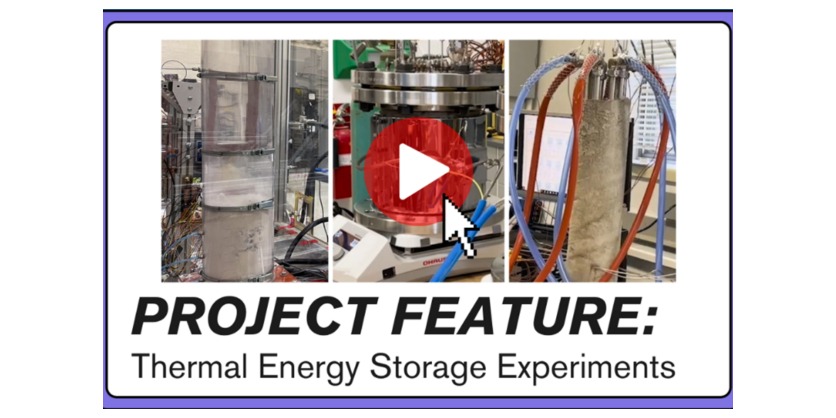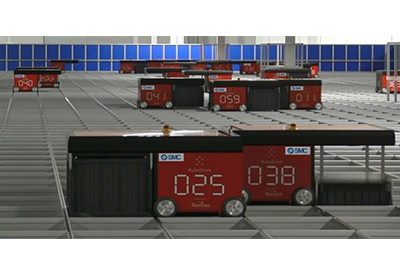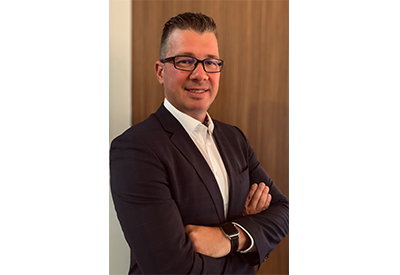CEDIR Labs’ Thermal Battery Research Strives to Support Canada’s Hybrid Energy Future
August 20, 2024

Could sand, molten salt and concrete hold the key to harnessing and repurposing heat produced from nuclear reactors?
As part of the first phase of Canadian Nuclear Laboratories’ (CNL) Clean Energy Demonstration, Innovation and Research (CEDIR) Initiative, a team of scientists are exploring how thermal batteries could connect to a nuclear, renewable-hybrid energy system.
Thermal batteries – also called thermal energy storage systems – store excess heat produced when demand is low and then release it back into the grid for use when demand is high.
Used internationally in the energy industry for more than a decade now, these systems can level out some of the up-and-down nature of energy demands, reduce the cost of energy by harvesting what’s produced during lower-cost times of day, reduce CO2 emissions, and, overall, contribute to a more flexible, more reliable energy supply.
But how would thermal energy storage systems interface with a nuclear-hybrid energy system?
“Nuclear power not only supports Canada’s efforts to increase the electricity supply, but it also offers a low-carbon heat supply that can be used towards heat-demanding industrial or commercial processes – like hydrogen fuel production or synthetic fuel production, for example, or even district heating,” says CEDIR’s technical lead Travis Pettigrew.
“Thermal energy storage could be the key to directly using this heat generated by the fission reactions going on inside nuclear reactors. Storage systems could act as the middle-man between a nuclear power plant and the commercial or industrial systems that require this heat.”
More broadly, hybrid energy systems (HES), which are composed of multiple energy sources and storage systems, offer a clean and reliable approach to meeting increased electricity and heating demands as we aim to rely less on carbon-emitting sources of energy.
Picture a nuclear reactor, solar panels, wind turbines, and storage batteries all working together to meet energy requirements for transportation, electricity, and heating and cooling for residential, commercial and industrial applications.
When combined, each energy source can play to its strength and increase the overall reliability of the energy supply. For example, a storage system could contribute to the supply when certain energy-generating technologies are unavailable. And, in turn, these technologies could charge up the storage system when they generate more than what’s needed.
“Remote and northern communities are ideal applications for hybrid energy systems, as they often struggle with high-cost and low-reliability electricity systems. These areas also tend to experience the largest climate change impacts due to the use of fossil fuels,” says Pettigrew.
“Being able to access more affordable and reliable energy could bring these communities new developments that improve their quality of life and local economy – like local food production, access to clean water, and industrial development,” he adds.
Within a nuclear-enabled hybrid energy system, specifically, thermal batteries could capture and store the heat produced from fission reactions taking place inside a nuclear reactor. This heat could then be used for residential, commercial, or industrial heating applications – like desalinating and treating water, warming up greenhouses to allow for agriculture in cold environments, or simply heating a home.
Three experiments are contributing to this multi-year thermal energy storage research project, which is one of many projects underway in the first phase of the CEDIR Initiative – CEDIR Labs.
In this first phase, CNL focuses on modelling and simulations, bench-scale demonstrations, integrating clean energy technologies and optimizing deployed technologies, ultimately working to understand the role of each clean technology in support of net-zero.
The second phase – CEDIR Park – will concentrate on hybrid energy infrastructure, growing modelling and bench-scale work into larger demonstrations, demonstrating the scalability of technologies, operating clean energy systems to generate economic and performance data and demonstrating the licensability of clean energy systems closely coupled with a nuclear reactor.
“These small-scale experiments are providing essential data to understand and characterize these technologies. This will inform future work and allow us to scale up these systems and study potential advantages of thermal storage system integration,” explains Pettigrew.
Within the thermal energy storage project, Reactor Safety Scientist Eric Dening Jia’s experiment is looking at sand’s ability to store high-grade heat, Research Scientist Chukwudi Azih’s experiment is looking at molten salt’s ability to store medium-grade heat, and Thermalhydraulics Analyst Ayman Mahmoud’s experiment is looking at concrete’s ability to store low-grade heat.
The three bench-scale experiments are currently their own separate apparatuses, but the plan is to connect them together to see how they interface with one another, as well as how they would interface with the heat produced from a nuclear reactor.
To see and learn more about the three experiments, watch the short videos below. And for more information about the CEDIR initiative, please visit CNL’s Clean Energy Demonstration, Innovation, and Research website.
ERIC DENING JIA’S SAND THERMAL ENERGY STORAGE EXPERIMENT
CHUKWUDI AZIH’S MOLTEN SALT THERMAL ENERGY STORAGE EXPERIMENT
AYMAN MAHMOUD’S CONCRETE THERMAL ENERGY STORAGE EXPERIMENT
Related Story
CNL Announces New Programs to Position Canada to Seize Opportunities in Fusion Energy
Canadian Nuclear Laboratories (CNL), Canada’s premier nuclear science and technology organization, is pleased to announce that it welcomed Canadian and international leaders in fusion science and technology to the nation’s capital earlier this week for Fusion Day 2024, a forum to discuss and explore the path to fusion deployment in Canada. Hosted by CNL at the Rideau Club in Ottawa, the event served as a venue for CNL to unveil and discuss its ‘Fusion Energy for Canada’ report, a new plan that outlines a collective vision and national strategy to make fusion energy a reality in Canada.




